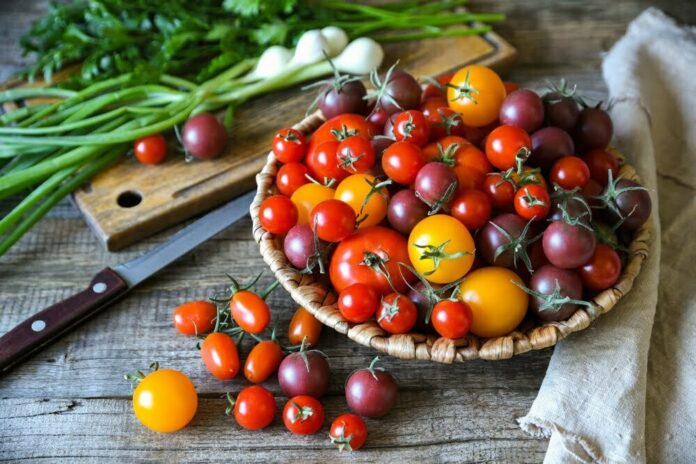In this Article
Choosing varieties
There are hundreds of varieties out there and generally if you are growing tomatoes from seeds, you can do this outside or in a greenhouse, there are many more varieties available than if you want to buy plug plants in the spring. Also growing from seeds is much cheaper as tomato plants can cost £3 in the garden centre in the spring.
Choose the variety according to how much space you have for your tomatoes and how you would like to use your fruit. Growing tomatoes is really rewarding and with just a few plants you can enjoy harvesting tomatoes by the middle of the summer. Just a few plants can produce enough fruit for a whole family in the summer months.
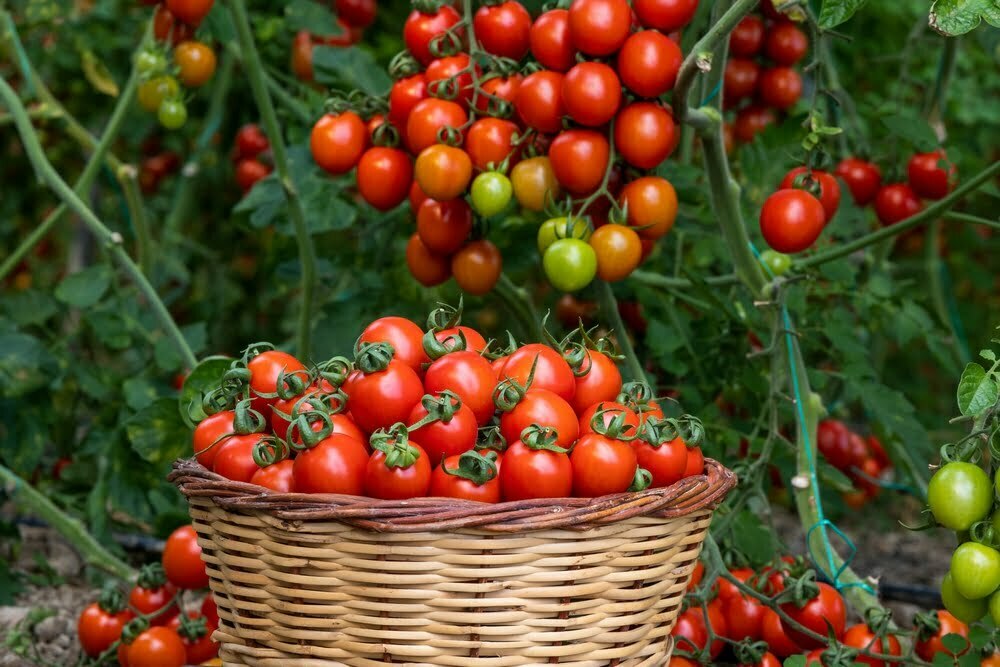
By fruit size
- Cherry tomatoes: A very popular option as these tomatoes can be used in salads, or can be eaten as a quick snack straight off the vine. Cherry tomatoes are ideal growing in pots.
- Medium sized fruits: This group can also be broken down into fruit shape. Round tomato varieties suit more for summer salads. Firmer mini plum tomatoes can also be found on the market which are great for people who like less juice in the tomatoes.
- Standard size: These are the best tomato variety for multi purpose use in the kitchen. Great for salads, cooking and even grilling for burgers and sauce making.
- Plum tomatoes: They are more meaty than the average tomato and the go to varieties for preserving, tomato sauce production and cooking.
- Beefsteak tomatoes: Brilliant in burgers. Best for grilling or making a delicious mozzarella salad as they slice very well. Also can be used for sauces.
Some old, traditional varieties are Moneymaker, Alicante and Ailsa Craig, these are standard sized red fruits, many gardeners are still growing them and many say they are reliable and easy to look after. However these tomatoes can be a bit on the boring side when it comes to taste.
Yellow fruits add an interesting colour to a salad in the summer, try few varieties and we can safely recommend Golden Sunrise, sweet and really juicy. What we like most are the heirloom black and purple varieties, they are really tasty and more and more gardeners grow them across the UK.
Black Russian and Black Krim are the favourites in my kitchen, they are really tasty in a sandwich or in a summer mozzarella salad. If you are growing tomatoes from seed outside, the black ones are generally quite hardy and early too, also Sub Arctic Plenty and Outdoor girl are a good outdoor type too.
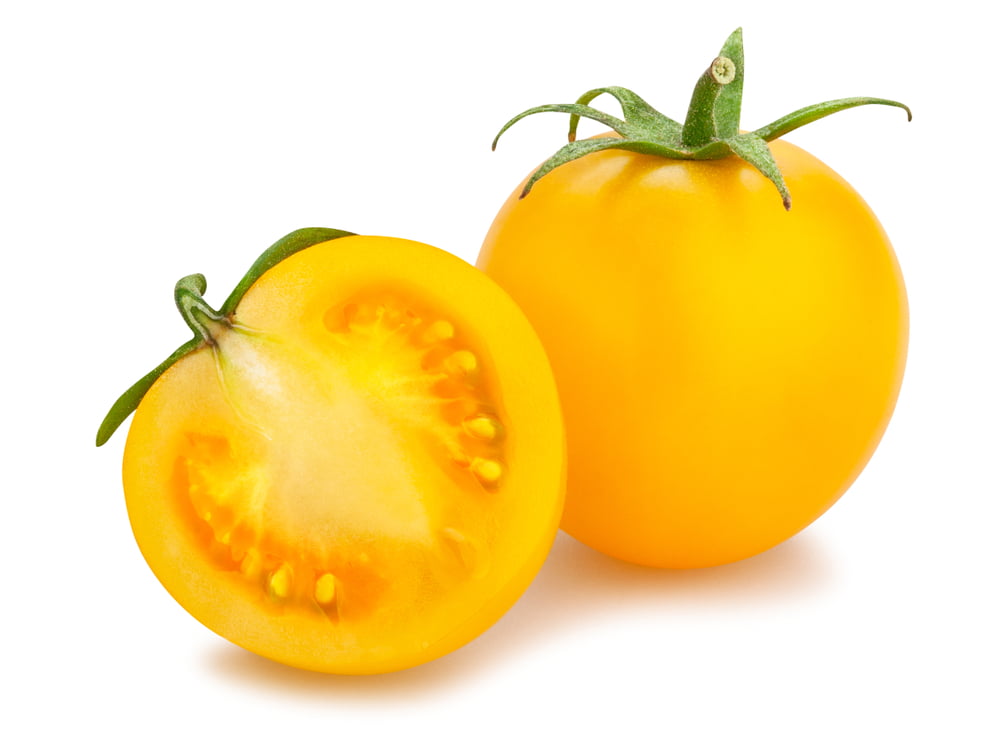
By growth habit
Choose your tomatoes by how much space you have available for your plants. Most varieties are cordon types which means you will need to stake them, but there are quite a few bush varieties too and they can be very prolific and good tasting too. Garden Pearl is a safe bet even if you want to grow tomatoes in hanging baskets.
- Determinate or bush tomatoes: Growing tomatoes as these are best suited in hanging baskets, pots and various containers. Also great for the patio as the plants grow maximum 40 cm tall. These tomatoes do not need the side shoots removed and do not need staking. Bush tomatoes are the best first time tomato for any gardener if you are just starting to grow tomatoes from seed.
- Indeterminate or cordon tomatoes: These plants will need some sort of support during the growing season. The most common technique is to use a single can next to the plants and restrict the growth to one single stem by pinching out the side-shoots.

Why Grow Tomatoes?
Tomatoes are not just absolutely delicious but very healthy too. They are full of minerals and vitamins, the below table is just a rough average, and I am sure that the home-grown tomatoes have even more goodness in them.
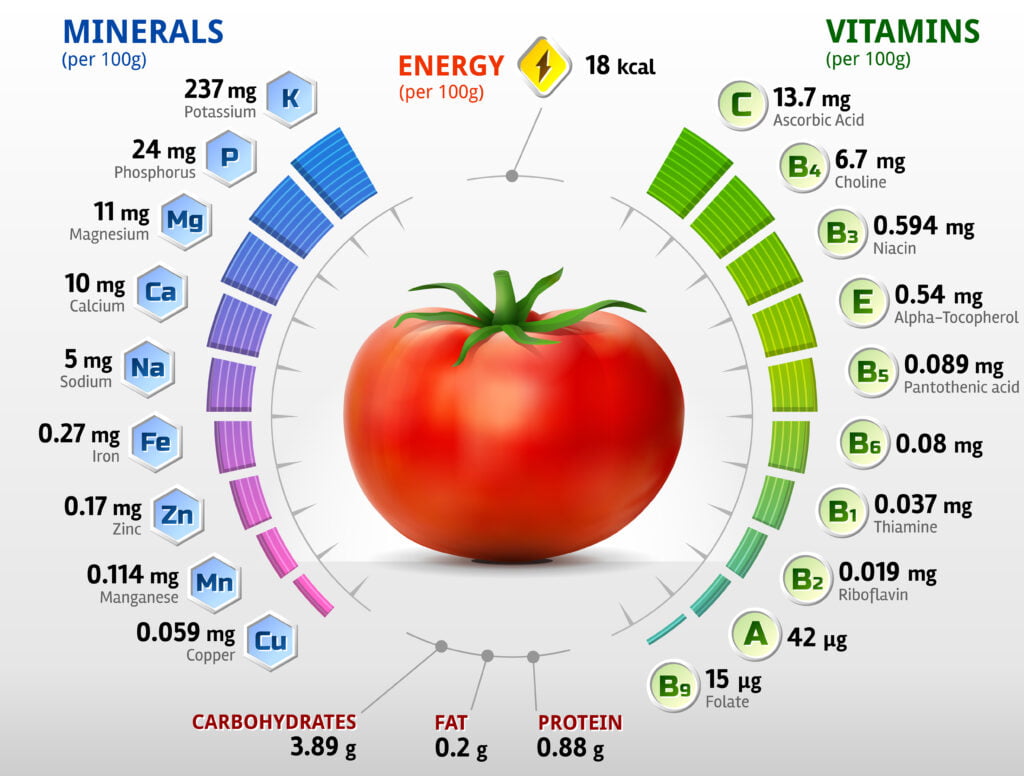
When to sow tomato seeds in the UK
Lots of people sow their tomato seeds in the unheated cold frame or greenhouse in the spring and they wonder why they will take a month to germinate. Tomatoes love heat. Growing tomatoes from seed means you have many more varieties to choose from. Seed germination takes 5 – 14 days depending on the temperature and tomato variety.
Sow the tomato seeds indoors in seed trays or in small plastic pots and place them in the windowsill or in the airing cupboard to get some heat. This will always help germination. Sow from February – April depending how much space you have and where you will grow them. If you place the seed tray in the airing cupboard take them out as soon as the tomato seedlings appear as they need full sun to grow.
If you have lots of room to grow tomatoes in your greenhouse and planning to get a head start, you can sow seeds in February and keep them inside as long as the weather gets warmer in late May. But if you have limited space inside for your tomatoes and the plants will have to go outside as soon as possible, then it is best to sow in April, so by the time the plants have 3 – 4 pairs of true leaves the weather is warmer outside so they can go straight into their final position in late May – early June.
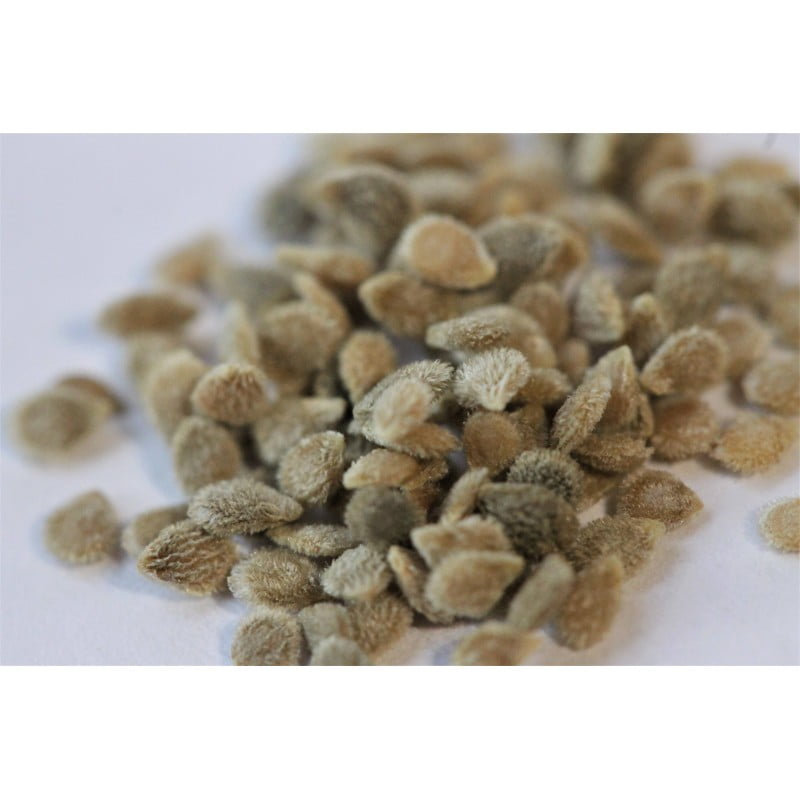
Sowing In the House
If you growing tomatoes in the greenhouse I would suggest sowing the tomato seeds indoors in the second half of March in good quality seed starting mix; and then plant the tomatoes in the greenhouse late April – early May; with some extra protection they will grow well and ahead of later sowings.
If you grow tomatoes outside sow the tomato seeds late March – early April.
Tomato seeds can be slow to germinate but the process can be sped up a few days, and depends on the temperatures, the seed compost you sowed them in and on the variety as well. As with any seeds it is best to cover them with about their own depth of compost. Seed packets will last probably for many seasons, tomato seeds keep well and be viable for up to 10 years and you can speed up the germination of the seeds.
Sowing In Greenhouse
You can sow tomatoes in unheated greenhouse too, late April is the best time for this. Even into their final position into a handful of good quality seed compost. The sunshine during the day will warm the soil temperature up to 25 Celsius which is ideal for the seeds to germinate. This way strong and vigorous plants can be grown and lot of the times they do catch up with indoor sowings, as they tend to grow leggy from the lack of sunlight.
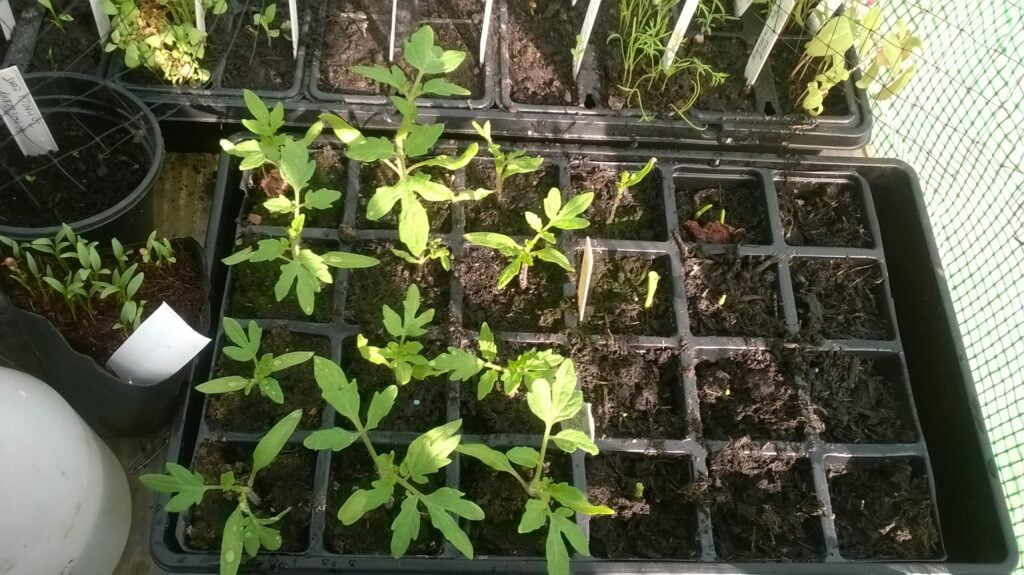
Potting on the tomato seedlings
When the seedlings are large enough to handle you will have to replant them into individual small – medium sized pots. It is better to repot more than once than planting them straight in big pots as in the rich compost a big root system can develop and not so much foliage growth.
Plant the tomato seedlings deep, be brave and put them as deep where the first pair of true leaves are, it can be a necessity because if your tomatoes are inside they don’t get enough light and get leggy. Make sure not to disturb the tender roots too much.
Water the plants regularly, as the nights are cold and the tomato plants don’t like sitting in cold water. Keep the compost moist and make sure they have enough water and not just the soil surface is wet. Provide plenty of light by turning the pots around every day on your windowsill, and place the tomatoes in the greenhouse as soon as no frost is expected.
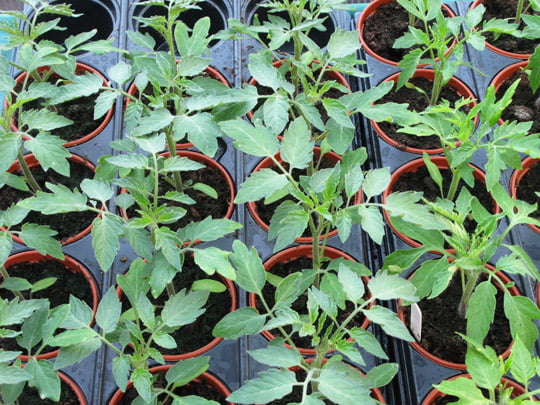
Planting tomatoes to their final position
It can be a large container, grow bag or open ground, in the greenhouse or outside. Whatever is your choice or availability make sure that no frost is expected and the daytime temperature is around 20 Celsius at least. Outdoor tomatoes will grow well too and grow strong once the weather warms up. Before you plant the tomatoes outside it is a good practise to acclimatise them to the outdoor conditions by hardening the tomato plants off.
Planting tomatoes in the ground has many advantages, even if it is the ground in the greenhouse, as the soil dries out slower saving lots of time and effort during the summer months and also there are more nutrients in the soil, with feeding you can only replace a certain quality and quantity of the nutrients the plants need.
Planting Outside
As mentioned above, place the young plants deep in the soil in early summer; sometimes the lower leaves die, this is natural and a small stress can cause it, whether the plant dried out a bit or had too much water and/or too low night time temperatures; these can all cause the oldest pair of leaves drop off or just turn yellow. So if this is the case, just remove the lowest pair of leaves.
Dig in plenty of well rotted manure in the previous autumn into the soil, or if you did not you can put a good amount of garden compost under the plants.
Cordon tomatoes need a small support right away by this stage of the growing season, you have various option to stake your outdoor plants.
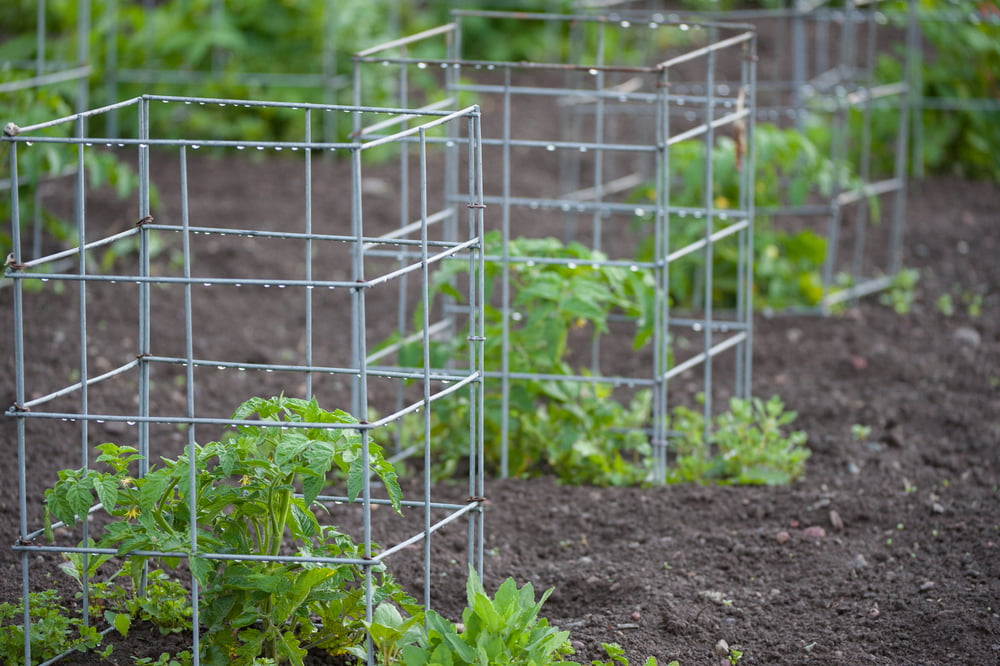
Planting in Greenhouse
Cherry tomatoes are the most fun to grow in the greenhouse as they can grow really tall and produce fruits well into September. Plant some flowers around the greenhouse, they will attract beneficial insects and pollinators will find their way into the greenhouse.
Tomato Plant Care
During the tomato growing season you need to do many tasks to keep the plants happy and to enjoy a great harvest. The bush tomatoes need less attention, and the cordon tomatoes need pruning and training frequently.
Mulching
If you grow many tomato plants outside it is a good idea to mulch in between the rows and under the plants as well. During the growing season there are lots of jobs you will have to do around the tomato plants and mulching will help not to harden the soil around them. It also helps to keep weeds down and keep the soil moist. All in all it will help you to have a bountiful crop. You can read more about mulching just click here.
Companion plants for tomatoes
Tomatoes do benefit from companion plants. Many gardeners plant marigolds and garlic around the tomato plants or in the entrance of the greenhouse where the tomatoes grow to repel greenflies and other harmful insects and also to attract bees and hoverflies.
Supporting the tomato plants
If you are growing tomatoes of the cordon varieties they need some support to grow up on. Most common is a cane but if you grow many plants in rows you can construct a cane and strong plastic net support for them. This is a good idea if you don’t want to prune them, it is a method used by only a few gardeners and they swear that the plants produce plenty of smaller fruits without pruning.
Tie the stems as needed to the canes using twine. Also the traditional method is to remove the side shoots of the cordon/indeterminate varieties to restrict the tomato plant to single stemmed plants in order to produce larger fruits and for the plants to be more controllable.
If you need more plants you can grow them from the side shoots; you can have more young plants by rooting the side shoots in a glass of water. When the roots start to appear you can plant them in potting soil.
Also remove the lower, yellowing leaves and some of the leaves from the middle of the growing tomato plant too if there are too many and the plants are too bushy, in order to aid air circulation around them.
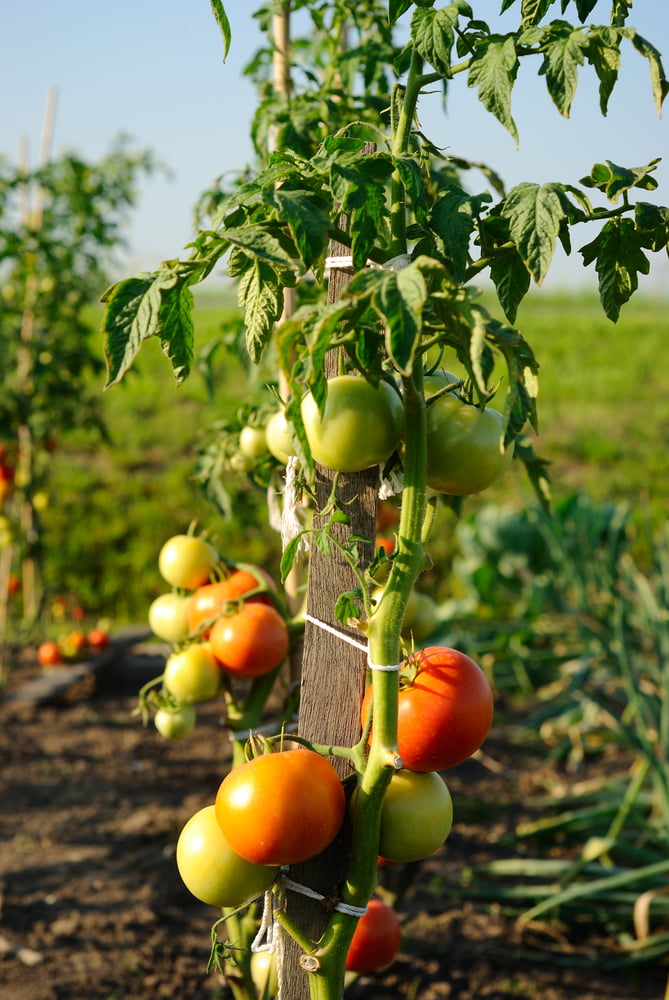
Feeding and watering regularly
Many gardeners suggest feeding when started flowering but it is recommended to feed tomatoes form an early stage, especially if you do not have a good fertile soil, as soon as you plant them out to their final position. If you have some nettles and/or comfrey around your garden or allotment plot, you can easily make homemade liquid fertiliser, it is just as good as a shop bought alternative. Irregular watering can cause blossom end rot, to prevent it you have to water the plants most days.

Pollinating the tomato flowers
In the greenhouse in hot summer days it can be very dry, to prevent the occurrence of dry set on tomatoes and peppers too, you should aid humidity in those days, also planting flowers around your greenhouse will help bees to find their way in there, just make sure you leave the door open during the day, so you can have a better pollination in the greenhouse.
Plants grown in the greenhouse might even need hand pollinating there are lack of bees, you can use a small paint brush for this. Hold the fruit trusses and gently brush the flowers around a few times.
Harvest tomatoes
You will realise that the whole fruit truss will not ripen at the same time but the fruits closer to the stem will first. In the shops most of the tomatoes are hybrid varieties which are bred for longer shelf life and uniformity of the fruits so that they look appealing. If you gain experience growing tomatoes you will know what is the best time to pick each variety.
If you have lots of unripe tomato fruit in October – November time you can pick them and take them inside the house, they will just ripen fine, or you can put them in a paper bag with a banana, as the ripening banana emits ethylene which accelerates ripening of other fruits around it. Ripe fruit feel always soft to the touch, and unripe fruit will feel rather hard.
Sometimes the developing fruit just stop growing, in this case use the not quite fully grown green tomatoes for chutney.
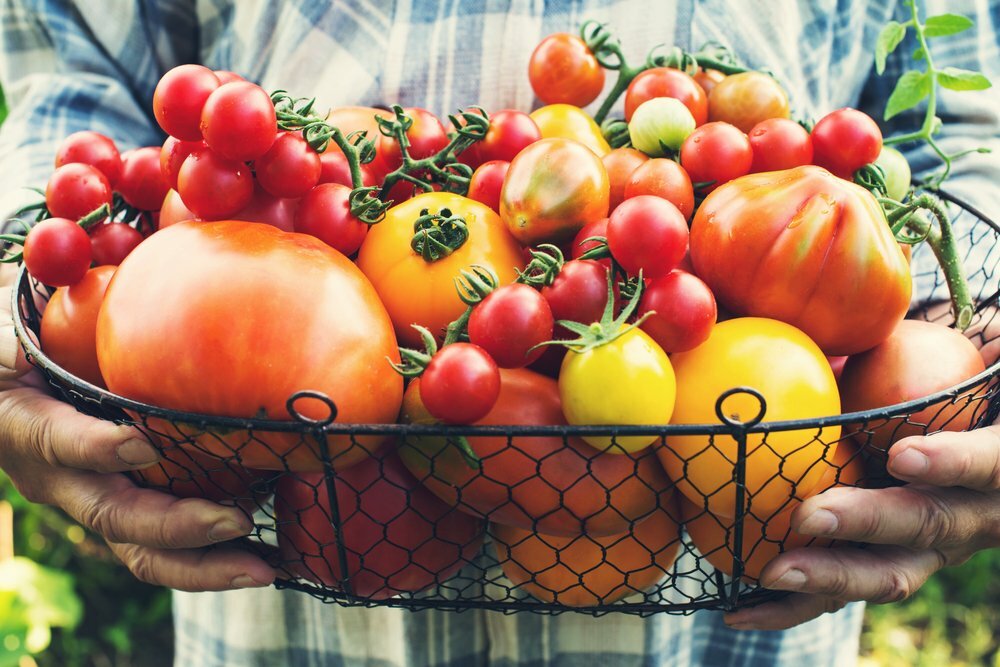
Storing tomatoes
There are plenty of methods and the most common is to store tomatoes in the fridge, they will last 7-12 days in there. You can make different pasta sauces, even puree and keep them in a jar. You can also freeze tomatoes although it is quite uncommon.
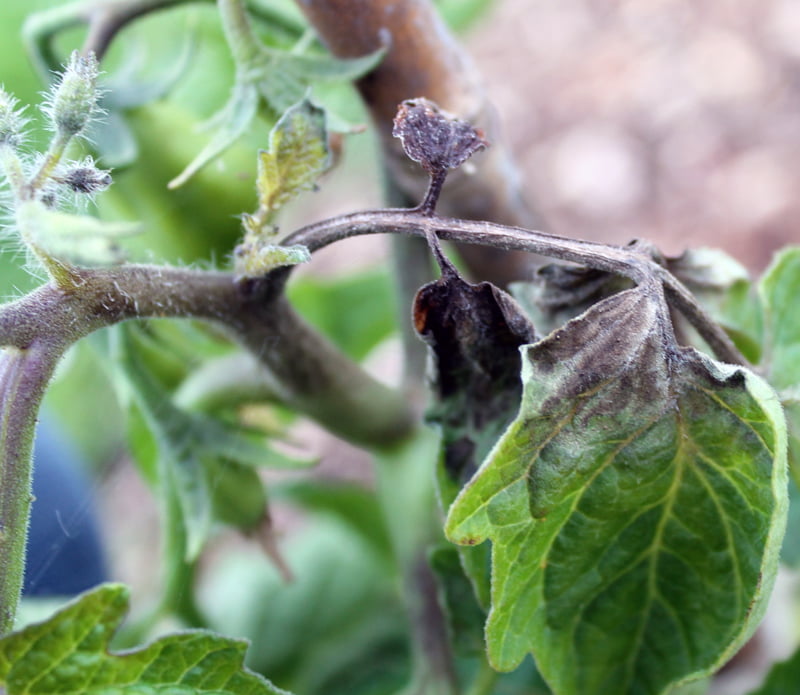
Tomato problems
The biggest problem in the UK is tomato blight. If you experience early onset of blight it is best to get rid of the diseased plants regularly and with a bit of lack you can save some of the healthiest ones by stopping the blight spreading everywhere. Late onset tomato blight is harder to deal with. You can try to remove the affected leaves only and see if the fruits can still grow.
There are also many different diseases you can encounter during the tomato growing season, although they are less common.
Magnesium or calcium deficiency on tomatoes can cause the leaves to yellow quite early on, try to use a specific fertiliser to remedy the problem or a rich compost from the start, which help help growing healthy plants.
Curly leaves on your growing tomatoes can be a sign of vigorous growth, and mostly you don’t have to worry about it, unless you see some unwanted insect visitors on the leaves. In which case you can use a home made garlic spray to get rid of white and green fly.

